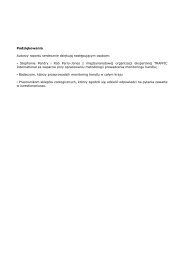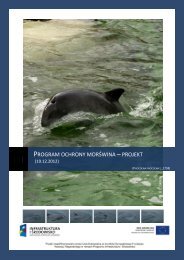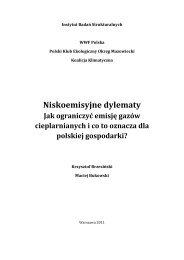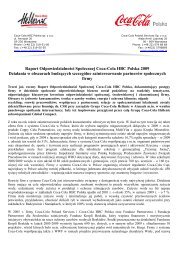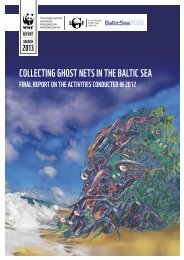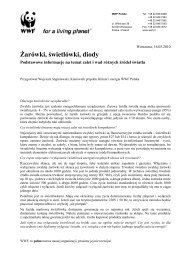Biodiversity, biocapacity and better choices
Biodiversity, biocapacity and better choices
Biodiversity, biocapacity and better choices
Create successful ePaper yourself
Turn your PDF publications into a flip-book with our unique Google optimized e-Paper software.
EcologicalFootprint: Futurescenarios(continued)EcosystemEcosystemservicesProvisioningservicesRegulatingservicesSupportingserviceswith the scenarios in food <strong>and</strong> energy were combined with the estimatesof the IPCC (IPCC, 2007b) <strong>and</strong> a l<strong>and</strong> suitability model (Global Agro-Ecological Zones – GAEZ) to predict changes in the area <strong>and</strong> suitabilityof l<strong>and</strong> for growing crops (Fischer et al., 2008).A dynamic complex of plant, animal <strong>and</strong> micro-organism communities<strong>and</strong> their non-living environment interacting as a functional unit.The Millennium Ecosystem Assessment distinguished supporting,provisioning, regulating <strong>and</strong> cultural services that contribute to humanwell-being (Millennium Ecosystem Assessment, 2005a; b). Theseservices are defined in the four panels below:Goods obtained directly from ecosystems (e.g., food, medicine, timber,fibre <strong>and</strong> bioenergy).Benefits obtained from the regulation of natural processes (e.g., waterfiltration, waste decomposition, climate regulation, crop pollination <strong>and</strong>regulation of some human diseases).Regulation of basic ecological functions <strong>and</strong> processes that are necessaryfor the provision of all other ecosystem services (e.g. nutrient cycling,photosynthesis <strong>and</strong> soil formation).HDIsimply not available <strong>and</strong> many opportunities remain inaccessible. Butthe realm of human development goes further: Essential areas of choice,highly valued by people, range from political, economic <strong>and</strong> socialopportunities for being creative <strong>and</strong> productive; to enjoying self-respect,empowerment <strong>and</strong> a sense of belonging to a community. The concept ofhuman development is a holistic one, putting people at the centre of allaspects of the development process. (Source: Human DevelopmentReport webpage).The HDI – Human Development Index – is a summary composite indexthat measures a country’s average achievements in three basic aspects ofhuman development: health, knowledge <strong>and</strong> a decent st<strong>and</strong>ard of living.The HDI contains three components:1. Health: Life expectancy at birth (number of years a newborn infantwould live if prevailing patterns of mortality at the time of birthwere to stay the same throughout the child’s life).2. Knowledge: A combination of the adult literacy rate <strong>and</strong>the combined primary, secondary <strong>and</strong> tertiary grossenrolment ratio.3. St<strong>and</strong>ard of living: GDP per capita (PPP US$).(Source: Human Development Report webpage).Cultural servicesGlobal hectare(gha)Hum<strong>and</strong>evelopmentPsychological <strong>and</strong> emotional benefits gained from human relationswith ecosystems (e.g., enriching recreational, aesthetic <strong>and</strong> spiritualexperiences).A productivity weighted area used to report both the <strong>biocapacity</strong> of theEarth, <strong>and</strong> the dem<strong>and</strong> on <strong>biocapacity</strong> (the Ecological Footprint). Theglobal hectare is normalized to the area-weighted average productivity ofbiologically productive l<strong>and</strong> <strong>and</strong> water in a given year. Because differentl<strong>and</strong> types have different productivity, a global hectare of, for example,cropl<strong>and</strong>, would occupy a smaller physical area than the much lessbiologically productive pasture l<strong>and</strong>, as more pasture would be needed toprovide the same <strong>biocapacity</strong> as one hectare of cropl<strong>and</strong>. Because worldbioproductivity varies slightly from year to year, the value of a gha maychange slightly from year to year (Global Footprint Network, 2012).Human development is a process of “enlarging” people’s <strong>choices</strong>.Enlarging people’s <strong>choices</strong> is achieved by exp<strong>and</strong>ing human capabilities<strong>and</strong> functioning. At all levels of development the three essentialcapabilities for human development are for people to lead long <strong>and</strong>healthy lives; to be knowledgeable; <strong>and</strong> to have a decent st<strong>and</strong>ard ofliving. If these basic capabilities are not achieved, many <strong>choices</strong> aresimply not available <strong>and</strong> many opportunities remain inaccessible. ButHuman development is a process of “enlarging” people’s <strong>choices</strong>.Enlarging people’s <strong>choices</strong> is achieved by exp<strong>and</strong>ing human capabilities<strong>and</strong> functioning. At all levels of development the three essentialcapabilities for human development are for people to lead long <strong>and</strong>healthy lives; to be knowledgeable; <strong>and</strong> to have a decent st<strong>and</strong>ard ofliving. If these basic capabilities are not achieved, many <strong>choices</strong> areInequalityadjustedHumanDevelopmentIndex (IHDI)Living PlanetIndex (LPI)The IHDI is a measure of the level of human development of people ina society that accounts for inequality. Under perfect equality, the IHDIis equal to the HDI; but it falls below the HDI when inequality rises. Inthis sense, the IHDI is the actual level of human development while theHDI can be viewed as an index of the potential human developmentthat could be achieved if there is no inequality. The IHDI accounts forinequality in HDI dimensions by “discounting” each dimension’s averagevalue according to its level of inequality.The average loss in the HDI due to inequality is about 23 percent – that is, adjusted for inequality, the global HDI of 0.682 in 2011would fall to 0.525. Countries with less human development tend to havegreater inequality in more dimensions – <strong>and</strong> thus larger losses in hum<strong>and</strong>evelopment.This new version of the HDI was developed for the 2011 HumanDevelopment Report (UNDP, 2011) <strong>and</strong> at the time of publication, theadjustment has been applied to 134 countries. For this definition <strong>and</strong>more information, see the IHDI homepage.The LPI reflects changes in the health of the planet’s ecosystems bytracking trends in over 9,000 populations of vertebrate species. Muchas a stock market index tracks the value of a set of shares over time asthe sum of its daily change, the LPI first calculates the annual rate ofchange for each species’ population in the dataset (example populationsare shown in Figures 4-6). The index then calculates the average changeacross all populations for each year from 1970, when data collectionbegan, to 2008, the latest date for which data is available (Collen et al.,2009 <strong>and</strong> see Annex 1 for more details).WWF Living Planet Report 2012 page 148 Annex: Technical notes <strong>and</strong> data tables page 149




